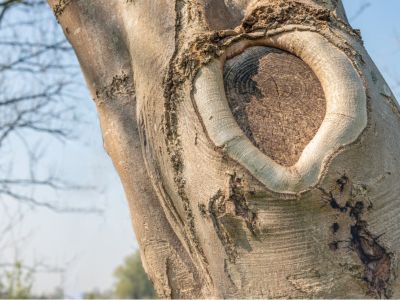How do trees get hurt? There are many different types of tree wounds, each with its own causes. Read on for information about tree wounds, as well as how you can help a wounded tree.
What Is a Tree Wound?
Exactly what is a tree wound? It is any injury to the tree that breaks the bark. This break can be small, like when someone pounds a nail into a tree trunk, or it can be huge, like when a large branch cracks off in the wind. Bark serves the same purpose as human skin: it is intended to keep out pathogens. Humans are mainly worried about bacteria getting into a cut or scratch, and trees can also suffer from bacterial infections. The other primary type of pathogen that can hurt a tree is fungus.
How Do Trees Get Hurt?
It’s impossible to list all the possible ways a tree can get wounded. Potential wounded tree causes range from deliberate actions by humans, like pruning, to accidental causes like fire or wind damage. Borer insects can cause tree wounds too by leaving holes in the bark. One very common way that people cause tree wounds is by operating machinery too close to a tree trunk. Many trees are injured every year by gardeners using lawnmowers, weed-whackers and the like. Nearby construction workers can also damage a tree. Another cause of wounded trees is leaving wire or twine wrapped around a tree. It can get imbedded in the bark as the tree grows. Certain chemicals gardeners use on their plants can hurt trees too. For example, herbicides with sub-lethal rates of glyphosate can cause tree wounds. Animals can wound trees, including deer, woodpeckers and mice. Weather events like lightning strikes and strong winds are among other wounded tree causes.
Preventing Tree Wounds
Given that so many types of tree wounds are caused by humans, it stands to reason that acting carefully and deliberately in the garden can prevent these wounds. Keep mowers away from trees, use integrated pest management methods of keeping pests away, and take off any wire or rope from around a trunk. Although pruning itself creates tree wounds, sometimes pruning can prevent greater damage. For example, pruning off broken or diseased branches limits damage. But never top a tree or leave pruning stubs that can rot. Perhaps the most important step you can take is to keep the tree healthy. That means picking an appropriate site and providing adequate irrigation to your trees. Also, a layer of mulch over a tree’s root area is a great way of locking in moisture and offering protection.
Tree Wound Care
Trees don’t heal the same way people do from wounds, since they can’t replace damaged tissues. Trees do have their own procedures for covering up wounds. Trees grow woundwood to close up their wounds. This is a type of callus tissue. Many trees also produce chemical and/or physical barriers to pathogens by walling off their injuries. When it comes to tree wound care, it’s often best to leave your trees alone when they have wounds rather than apply wound sealants or paint, since these products do not prevent decay. Sometimes corrective pruning can help but it is often better to have an arborist review the damage first.
